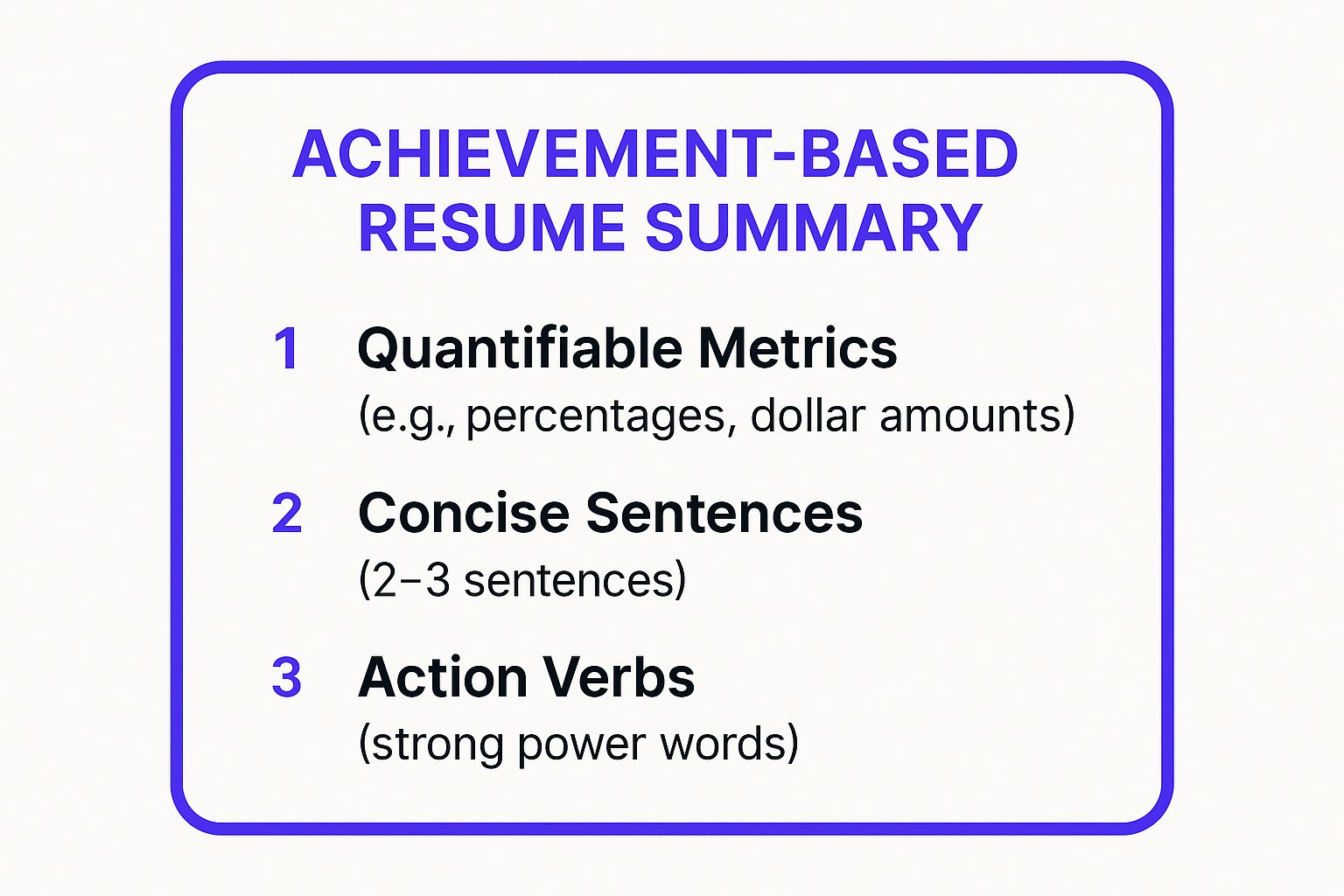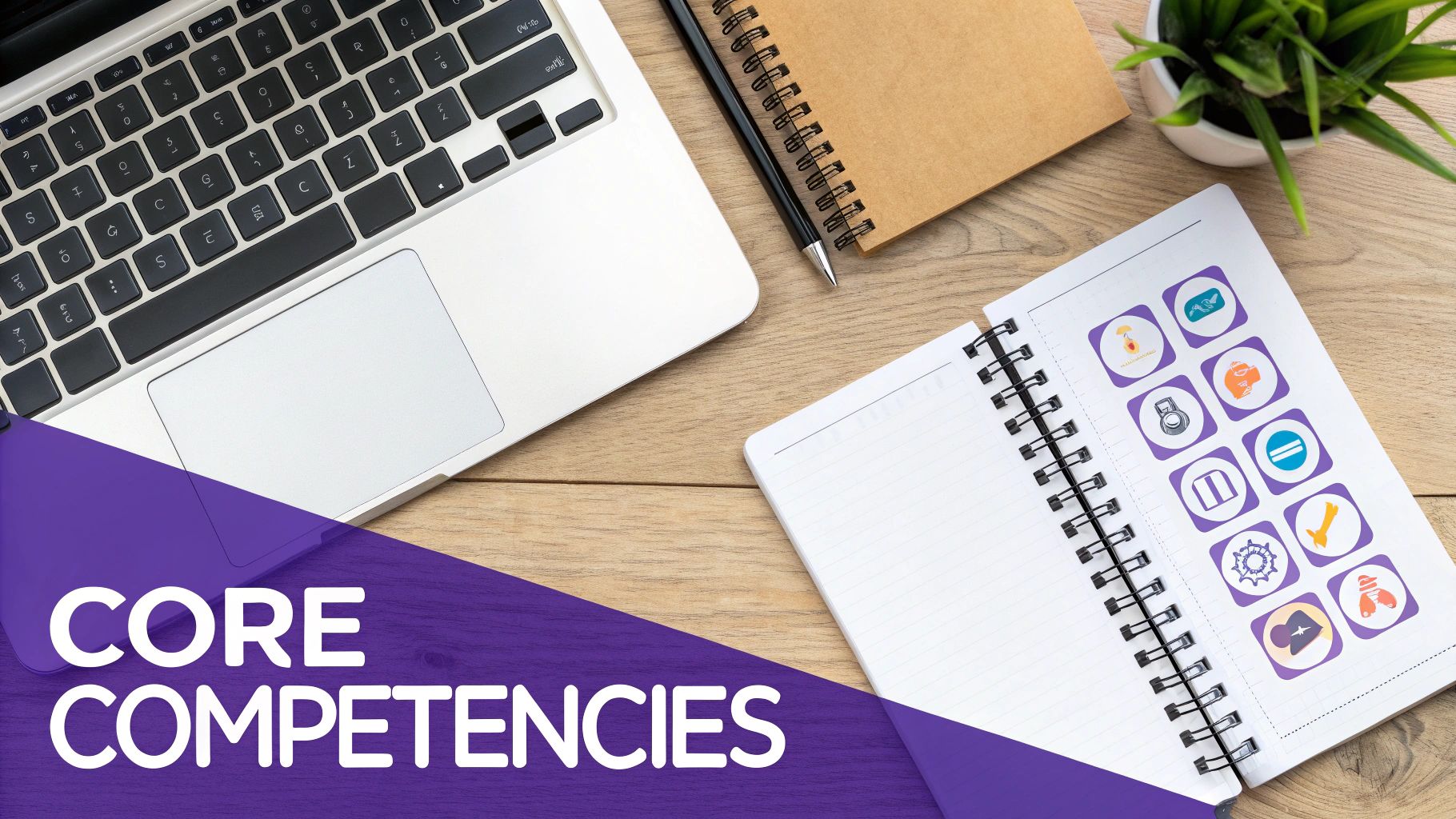Resume Summary Qualifications Examples to Shine Your Application
In a crowded job market, your resume has about 30 seconds to capture a hiring manager's attention. The first section they see, your professional summary, determines whether they keep reading or move on. A powerful, well-crafted summary of qualifications acts as a strategic preview, compelling them to invest more time in your application. Conversely, a weak or generic one can lead to an instant rejection, regardless of how qualified you are for the role.
This article provides a detailed breakdown of effective resume summary qualifications examples tailored for different roles and career stages. We will move beyond basic templates to analyze the specific strategies that make each summary work. You will learn not just what to write, but why certain phrases, metrics, and keywords are essential for passing both automated Applicant Tracking Systems (ATS) and the critical eye of a human recruiter.
Each example is dissected to reveal its core tactics, offering actionable takeaways you can immediately apply to your own resume. Whether you are a recent graduate, a seasoned executive, or making a career change, you'll find replicable methods to craft a summary that highlights your most valuable achievements and skills, ensuring your resume gets the attention it deserves and lands you that crucial interview.
1. Achievement-Based Summary
An Achievement-Based Summary immediately grabs a recruiter’s attention by leading with quantifiable results and measurable impact. Instead of simply listing job duties, this approach showcases your direct contributions and proven value from previous roles. It answers the employer's core question: "What can this candidate do for us?" by providing concrete evidence of past success.
This type of summary is one of the most powerful resume summary qualifications examples because it shifts the focus from responsibilities to results. It tells a story of accomplishment, positioning you as a high-impact candidate who delivers tangible outcomes.
How It Works: The Breakdown
The strategy is to combine your professional title and years of experience with your most impressive, data-backed achievements. This creates a concise, powerful pitch that is hard for hiring managers to ignore.
- Example 1 (Sales): “Sales Manager with 8+ years driving revenue growth, achieving 150% of quota for 3 consecutive years and generating $2.3M in new business.”
- Example 2 (Marketing): “Digital Marketing Specialist who increased website traffic by 340% and conversion rates by 28% through strategic SEO and content marketing campaigns.”
- Example 3 (Project Management): “Project Manager with a proven track record of delivering 95% of projects on time and 15% under budget, managing cross-functional teams of up to 25 members.”
Each example uses strong action verbs, specific metrics, and a clear job title to create a compelling narrative of success.
Key Elements of a Winning Achievement-Based Summary
To help you build your own impactful summary, this infographic highlights the three essential components.

This visual guide emphasizes that combining quantifiable metrics with powerful action verbs in a concise format is the key to an effective achievement-based summary.
Actionable Takeaways
To craft your own achievement-based summary, focus on these practical steps:
- Use the STAR Method: Identify your strongest accomplishments by outlining the Situation, Task, Action, and Result of your key projects. The "Result" is where you'll find your best metrics.
- Quantify Everything Possible: Translate your accomplishments into numbers. Use percentages, dollar amounts, time saved, or units produced.
- Align with the Job Description: Tailor your summary by highlighting achievements that directly correspond to the requirements and desired outcomes listed in the job posting.
By front-loading your resume with proven results, you create a powerful first impression that sets you apart from other applicants. For more tips on enhancing your entire resume, explore these strategies on how to make your resume better.
2. Skills-Focused Professional Summary
A Skills-Focused Professional Summary highlights your core competencies, technical abilities, and professional capabilities that are most relevant to the target job. This format is ideal for technical roles, career changers, or anyone whose most valuable asset is a specific skill set. It directly addresses the employer's need for specific expertise, making it clear from the start that you possess the required qualifications.
This approach is one of the most effective resume summary qualifications examples because it acts as a direct answer to the technical requirements in a job description. It quickly validates your candidacy for roles where specific hard skills, software proficiency, or technical knowledge are non-negotiable.

How It Works: The Breakdown
The strategy is to lead with your most in-demand skills, tools, and areas of expertise, framed by your professional title and years of experience. This immediately signals to both applicant tracking systems (ATS) and human recruiters that your qualifications align with the job's technical needs.
- Example 1 (Software Development): “Software Developer with 6+ years of experience in full-stack development, specializing in JavaScript, React, Node.js, and cloud deployment. Expertise in agile methodologies, database optimization, and API integration.”
- Example 2 (Graphic Design): “Graphic Designer skilled in Adobe Creative Suite, brand development, and digital marketing design. Proven ability to translate client vision into compelling visual content that drives engagement and conversions.”
- Example 3 (Finance): “Financial Analyst with expertise in financial modeling, forecasting, and data analysis using Excel, SQL, and Tableau. Strong background in budget planning and variance analysis.”
Each example clearly lists the most relevant hard skills and technical tools, positioning the candidate as a subject-matter expert ready to contribute from day one.
Key Elements of a Winning Skills-Focused Summary
To build a compelling skills-focused summary, you must be strategic in your selection and presentation. The goal is to create a condensed yet powerful snapshot of your technical capabilities.
This visual guide emphasizes that a successful summary balances your job title with a curated list of high-impact skills and relevant soft skills to create a well-rounded professional profile.
Actionable Takeaways
To craft your own skills-focused summary, follow these practical steps:
- Mirror the Job Description: Scrutinize the "Requirements" or "Qualifications" section of the job posting. Prioritize the skills and software they mention most prominently in your summary.
- Use Industry-Standard Terminology: List skills and technologies using their official names (e.g., "Adobe Creative Suite," "Salesforce," "Python"). This ensures your resume is optimized for ATS scans.
- Balance Hard and Soft Skills: While the focus is on technical abilities, including one or two relevant soft skills (like "agile methodologies" or "client communication") adds valuable context and shows you are a well-rounded professional.
By showcasing your most relevant skills upfront, you make it easy for hiring managers to see you as a perfect match. To further enhance your resume, discover which keywords will make your application stand out by exploring these insights on how to choose the right resume keywords to use.
3. Industry-Specific Summary
An Industry-Specific Summary is crafted to speak the language of a particular field, demonstrating an immediate and deep understanding of its unique challenges, terminology, and standards. Instead of a generic overview, this approach highlights your expertise within a specific sector, proving you are not just a qualified professional but an insider who can add value from day one.
This is one of the most effective resume summary qualifications examples for roles where deep domain knowledge is critical. It signals to recruiters that you understand the industry landscape, its regulations, and its key performance indicators, making you a low-risk, high-reward candidate who can seamlessly integrate into their team.
How It Works: The Breakdown
The strategy involves blending your professional experience with industry-specific keywords, certifications, and accomplishments that resonate with hiring managers in that sector. It shows you are fluent in the industry’s operational language and have solved the exact problems they face.
- Example 1 (Healthcare): “Healthcare Administrator with 10+ years managing multi-specialty practices, ensuring HIPAA compliance, optimizing EHR systems, and improving patient satisfaction scores by 25% through process improvement initiatives.”
- Example 2 (Retail): “Retail Operations Manager experienced in omnichannel strategy, inventory optimization, and loss prevention. Proven success in driving same-store sales growth and implementing customer experience enhancements.”
- Example 3 (Cybersecurity): “Cybersecurity Specialist with expertise in threat assessment, incident response, and compliance frameworks including ISO 27001 and NIST. Certified in CISSP and CEH with experience protecting enterprise networks.”
Each example uses jargon and metrics specific to its field (HIPAA, omnichannel, NIST) to build immediate credibility and relevance.
Actionable Takeaways
To create your own compelling industry-specific summary, follow these steps:
- Master the Jargon: Study the job description and industry publications to identify and incorporate key terminology, technologies, and regulatory standards.
- Highlight Relevant Certifications: Prominently feature certifications that are highly valued in your industry (e.g., PMP for project management, CPA for accounting).
- Solve Their Problems: Frame your achievements around solving common industry pain points. For finance, this could be risk mitigation; for manufacturing, it might be supply chain optimization.
By tailoring your summary with industry-specific language and insights, you present yourself as an expert who is perfectly aligned with the employer’s world.
4. Career Change Summary
A Career Change Summary is a strategic introduction designed for professionals transitioning to a new industry or role. This summary addresses the pivot head-on by emphasizing transferable skills, passion for the new field, and any recent, relevant training. It skillfully bridges the gap between past experience and future aspirations.
This approach is one of the most crucial resume summary qualifications examples for career changers because it reframes their background in the context of the new role. It helps hiring managers see potential and transferable value instead of a lack of direct experience.

How It Works: The Breakdown
The goal is to connect the dots for the recruiter, showing how your seemingly unrelated experience is highly relevant. This is done by highlighting universal skills like leadership, project management, or communication alongside new, role-specific qualifications.
- Example 1 (Military Veteran to Project Management): “Decorated military leader with 12+ years of experience in strategic planning and team coordination transitioning into corporate project management. Recently completed PMP certification and Agile training to apply proven leadership and operational excellence in a new environment.”
- Example 2 (Teacher to Corporate Training): “Educator with 8+ years of experience in curriculum development and instructional design, now seeking a Corporate Training role. Leverages expertise in adult learning principles and presentation skills to engage diverse audiences and measure learning outcomes.”
- Example 3 (Marketing to UX Design): “Creative marketing professional pivoting to UX Design, combining a background in user behavior analysis with newly acquired skills in user research, wireframing, and prototyping from an intensive UX bootcamp. Portfolio available upon request.”
Key Elements of a Winning Career Change Summary
This video from Andrew LaCivita offers excellent advice on how to frame your career pivot to recruiters, reinforcing the strategies needed for an effective transition.
Watching this can help you articulate your story with confidence and clarity, a key component of a successful career change.
Actionable Takeaways
To build a compelling career change summary, follow these steps:
- Lead with Your Goal: State the new role or industry you are targeting to set a clear context from the start.
- Identify Transferable Skills: Analyze your past roles for skills that are valuable in your new field, such as communication, leadership, data analysis, or client management.
- Showcase New Qualifications: Prominently feature any recent certifications, courses, or workshops that demonstrate your commitment and prove you have the foundational knowledge for the new role.
By crafting a narrative of deliberate growth and transferable value, you position yourself as an adaptable and motivated candidate ready for a new challenge. To dive deeper into this topic, find more strategies on how to successfully pivot your career.
5. Executive Leadership Summary
An Executive Leadership Summary is tailored for C-suite, VP, or director-level roles, shifting the focus from hands-on tasks to strategic vision, organizational impact, and enterprise-wide influence. This summary communicates your capacity to steer an entire company, drive market-changing initiatives, and manage complex stakeholder relationships. It answers the employer's core question: "Can this person lead our entire organization to success?"
This format is one of the most strategic resume summary qualifications examples because it highlights macro-level achievements like M&A, digital transformation, and market expansion. It positions you not just as a manager, but as a visionary leader who shapes the future of the business.
How It Works: The Breakdown
The strategy is to blend your senior title with your most significant, large-scale accomplishments that demonstrate strategic oversight and financial impact. This creates a high-level narrative of executive competence that resonates with boards and executive search firms.
- Example 1 (CEO): “Fortune 500 CEO with 20+ years driving digital transformation and sustainable growth. Led a $2.5B organization through a successful turnaround, achieving a 35% revenue increase while expanding into 12 new markets.”
- Example 2 (CTO): “Chief Technology Officer specializing in enterprise-scale innovation and team leadership. Built technology organizations from 50 to 500+ employees while delivering products used by 10M+ customers globally.”
- Example 3 (CFO): “Chief Financial Officer with expertise in M&A, capital raising, and financial strategy. Successfully led 8 acquisitions totaling $500M+ and guided the company through an IPO generating $200M in capital.”
Each example uses language focused on enterprise-level impact, large-scale numbers (billions, millions), and strategic business functions like M&A, IPOs, and turnarounds.
Key Elements of a Winning Executive Leadership Summary
For senior leaders, a summary must convey authority, vision, and a history of significant financial stewardship. The core components are designed to appeal directly to a board of directors or executive hiring committee.
- Enterprise-Level Metrics: Focus on metrics that affect the entire organization, such as revenue growth, market share, shareholder value, and operational efficiency improvements across multiple departments.
- Strategic Vision: Mention key strategic initiatives you've led, like digital transformations, global expansions, or post-merger integrations. This shows you're a forward-thinking leader.
- Leadership Scope: Quantify the scale of your leadership. Include the size of the P&L you managed, the number of employees in your organization, or the number of countries you operated in.
This approach demonstrates that you operate at the highest level, making decisions that have a lasting impact on the entire business.
Actionable Takeaways
To craft your own executive leadership summary, focus on these practical steps:
- Think Like a Board Member: What are the top three accomplishments that would convince a board you can protect and grow their investment? Start with those.
- Highlight Strategic Functions: Emphasize experience with M&A, capital raising, investor relations, board governance, and change management. These are key responsibilities at the executive level.
- Showcase Thought Leadership: Include industry recognition, speaking engagements, or publications. This validates your expertise and positions you as an influential voice in your field.
By focusing on high-level strategic impact, you create a powerful summary that aligns with the expectations for a senior leadership role. For further guidance on optimizing your executive resume, you can check out this article on resume tips from recruiters.
6. Recent Graduate Summary
A Recent Graduate Summary is specifically designed for individuals with limited professional experience. Instead of relying on a long work history, this format showcases potential by highlighting academic achievements, relevant projects, internships, and valuable skills. It effectively bridges the gap between education and the professional world, answering the employer’s question: "Why should I hire someone new?" by demonstrating drive, knowledge, and practical application.
This type of summary is one of the most critical resume summary qualifications examples for early-career candidates. It shifts the narrative from what you have done in a corporate setting to what you are capable of doing, positioning you as a motivated, adaptable, and high-potential hire.
How It Works: The Breakdown
The strategy is to combine your academic credentials with any practical experience, hard skills, and notable extracurricular activities. This creates a compelling pitch that showcases your readiness to contribute from day one, even without years of formal job experience.
- Example 1 (Marketing): “Recent Marketing Graduate with internship experience at a Fortune 500 company, where I contributed to a social media campaign that increased engagement by 40%. A Dean's List student with leadership experience in student government and the marketing club.”
- Example 2 (Tech): “Computer Science Graduate with hands-on experience in software development through a comprehensive capstone project and coding bootcamp. Proficient in Java, Python, and SQL, with strong problem-solving abilities demonstrated through successful hackathon participation.”
- Example 3 (Business): “Business Administration Graduate (3.8 GPA) with summer internship experience in financial analysis and a part-time retail management role. Proven ability to balance demanding academics with work responsibilities while developing key leadership skills.”
Each example uses academic titles, quantifiable achievements from internships or projects, and relevant skills to build a strong case for the candidate's potential.
Key Elements of a Winning Recent Graduate Summary
Building a summary without extensive job history requires focusing on different but equally valuable assets. The key is to translate academic and extracurricular experiences into professional qualifications. For those still building their experience, crafting an effective summary often involves highlighting potential and academic achievements; find more specific guidance on a resume for recent graduates.
Actionable Takeaways
To craft your own impactful recent graduate summary, focus on these practical steps:
- Lead with Your Education: Start with your degree and major, as this is your primary qualification. Mention your GPA if it is 3.5 or higher.
- Showcase Practical Experience: Highlight internships, co-ops, volunteer work, or significant academic projects. Use numbers to quantify your contributions wherever possible (e.g., "assisted in managing a $5,000 project budget").
- Emphasize Transferable Skills: Pull keywords from the job description, such as "team collaboration," "project management," "data analysis," or specific software. Connect these skills to your experiences, whether from a class project or a part-time job.
By focusing on your potential, skills, and academic accomplishments, you create a powerful first impression that proves you are a valuable and motivated candidate. For more strategies on launching your career, explore these tips on how to find a job after graduation.
Resume Summary Types Comparison Table
| Summary Type | 🔄 Implementation Complexity | ⚡ Resource Requirements | 📊 Expected Outcomes | 💡 Ideal Use Cases | ⭐ Key Advantages |
|---|---|---|---|---|---|
| Achievement-Based Summary | Medium: Requires gathering specific metrics and crafting concise content | Medium: Research company metrics and tailor examples | High: Demonstrates measurable impact and ROI potential | Mid-level to senior professionals; sales, marketing, management roles | Grabs attention quickly; concrete evidence; differentiates candidate |
| Skills-Focused Professional Summary | Low to Medium: Lists skills and certifications, customization needed | Low: Focus on relevant skills and keywords | Medium: Highlights competencies; passes ATS filters | Technical professionals, career changers, creative roles | Easy to customize; good for ATS; highlights transferable skills |
| Industry-Specific Summary | Medium to High: In-depth industry knowledge and terminology required | Medium: Research industry trends and certifications | High: Shows expertise, cultural fit, and credibility | Specialized professionals in regulated or niche markets | Demonstrates deep industry understanding; resonates with managers |
| Career Change Summary | High: Requires strategic framing and extensive research | Medium to High: Education, certifications, networking efforts | Medium: Overcomes gaps, shows adaptability and motivation | Career changers, veterans, returning professionals | Highlights transferable skills; positions fresh perspective |
| Executive Leadership Summary | High: Needs significant leadership experience and strategic data | High: Must gather enterprise-level metrics and accomplishments | Very High: Positions candidate for top leadership roles | C-suite executives, senior VPs, board members | Emphasizes strategic impact; appeals to executive recruiters |
| Recent Graduate Summary | Low: Focuses on academics and internships | Low: Leverages academic projects and extracurriculars | Medium: Highlights potential and eagerness to learn | New graduates, entry-level candidates | Makes limited experience stand out; emphasizes learning agility |
Putting It All Together: Your Blueprint for a Winning Summary
We've explored a wide range of resume summary qualifications examples, from the achievement-driven executive to the skills-focused recent graduate. The common thread connecting them all is a commitment to strategic customization. A powerful summary doesn't just list what you’ve done; it builds a compelling case for why you are the ideal candidate for a specific role, right now.
The most effective summaries are not one-size-fits-all. They are meticulously crafted narratives that bridge your past accomplishments with a company's future needs. By dissecting the examples for career changers, industry specialists, and leaders, you've seen how a few carefully chosen sentences can reframe an entire career trajectory to align perfectly with a job description.
Your Actionable Blueprint
Transforming these insights into your own winning summary requires a structured approach. Think of it as a three-step process to synthesize your unique value proposition.
- Identify Your Core Value: Before writing a single word, ask yourself: What is the primary problem this role solves? Then, pinpoint the 2-3 key qualifications or achievements you possess that directly address that problem. This becomes the central theme of your summary.
- Quantify Your Impact: Move beyond simply stating responsibilities. As seen in the achievement-based examples, numbers are your most powerful tool. Dig into your past work to find metrics related to revenue growth, cost savings, efficiency improvements, or team expansion.
- Align with Keywords: Review the job description and identify essential keywords and phrases. Seamlessly integrate these terms into your summary to ensure your resume is optimized for Applicant Tracking Systems (ATS) and immediately signals your relevance to a human reader.
Mastering this process is a game-changer. It elevates your resume from a historical document to a forward-looking marketing tool. This targeted approach demonstrates not only your qualifications but also your genuine interest and strategic thinking, setting you apart in a crowded applicant pool. A polished, professional presentation can further enhance this impression. Beyond perfecting your summary, consider modern advancements for enhancing your entire application, such as leveraging AI to design your CV for a standout look.
Ultimately, your resume summary is your 30-second elevator pitch. It’s your first and best chance to capture a recruiter's attention and convince them to keep reading. By applying the frameworks and tactical insights from the resume summary qualifications examples in this guide, you are now equipped to craft a powerful introduction for every application. Go forward and build the summary that opens the door to your next great opportunity.
Ready to stop guessing and start building perfectly tailored summaries in seconds? Eztrackr’s AI-powered resume builder and skill-match analyzer instantly compares your qualifications to any job description, helping you craft a high-impact summary that gets noticed. Take control of your job search and turn applications into interviews with Eztrackr.
 Interview Sidekick
Interview Sidekick